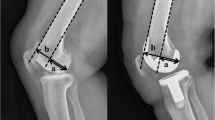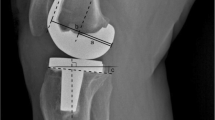Abstract
Purpose
Anterior referencing and posterior referencing are two major techniques for positioning femoral components and balancing the sagittal plane during total knee arthroplasty (TKA). The purpose of this study was to evaluate the changes in medial and lateral posterior condylar offset (PCO) after bilateral TKA using anterior referencing (AR) or posterior referencing (PR) systems and compare the effect of the PCO changes on knee flexion.
Methods
Twenty female patients (mean age, 68.6 years) underwent bilateral TKA using the AR technique in one knee and the PR technique in the contralateral knee. Three-dimensional reconstructed computed tomographic images from the sagittal plane were used to evaluate PCO before and after arthroplasty. Knee Society scores and range of motion were evaluated postoperatively at a mean of 2.9 years.
Results
Postoperative medial and lateral PCOs were significantly greater (p < 0.001 and p = 0.048, respectively) in the AR group (30.9 ± 2.2 and 29.1 ± 1.5 mm, respectively) than those in the PR group (29.1 ± 2.7 and 27.3 ± 2.3 mm, respectively). In addition, the degree of change in the PCO after TKA was greater in the AR group than in the PR group. On the final follow-up, no differences in the degree of knee flexion were observed between the two groups (124.7° for AR and 124.5° for PR). Knee Society scores were similar in the two groups both preoperatively and postoperatively. On the final follow-up, individual changes in the medial and lateral PCO were not associated with changes in the knee flexion angle.
Conclusions
Restoration of PCO after TKA was more accurate with the PR technique than with the AR technique. However, the postoperative differences in PCO showed no correlation with changes in knee flexion 2 years after PCL-substituting TKA.
Level of evidence
Therapeutic study, Level I.


Similar content being viewed by others
References
Arabori M, Matsui N, Kuroda R, Mizuno K, Doita M, Kurosaka M, Yoshiya S (2008) Posterior condylar offset and flexion in posterior cruciate-retaining and posterior stabilized TKA. J Orthop Sci 13(1):46–50
Bauer T, Biau D, Colmar M, Poux X, Hardy P, Lortat-Jacob A (2010) Influence of posterior condylar offset on knee flexion after cruciate-sacrificing mobile-bearing total knee replacement: a prospective analysis of 410 consecutive cases. Knee 17(6):375–380
Bellemans J, Banks S, Victor J, Vandenneucker H, Moemans A (2002) Fluoroscopic analysis of the kinematics of deep flexion in total knee arthroplasty. Influence of posterior condylar offset. J Bone Joint Surg Br 84(1):50–53
Callaghan JJ, O’Rourke MR, Saleh KJ (2004) Why knees fail: lessons learned. J Arthroplasty 19(4 Suppl 1):31–34
Clarke HD, Hentz JG (2008) Restoration of femoral anatomy in TKA with unisex and gender-specific components. Clin Orthop Relat Res 466(11):2711–2716
Fokin AA, Heekin RD (2014) Anterior referencing versus posterior referencing in total knee arthroplasty. J Knee Surg 27(4):303–308
Fujimoto E, Sasashige Y, Masuda Y, Hisatome T, Eguchi A, Masuda T, Sawa M, Nagata Y (2013) Significant effect of the posterior tibial slope and medial/lateral ligament balance on knee flexion in total knee arthroplasty. Knee Surg Sports Traumatol Arthrosc 21(12):2704–2712
Gatha NM, Clarke HD, Fuchs R, Scuderi GR, Insall JN (2004) Factors affecting postoperative range of motion after total knee arthroplasty. J Knee Surg 17(4):196–202
Geijsen GJ, Heesterbeek PJ, van Stralen G, Anderson PG, Wymenga AB (2014) Do tibiofemoral contact point and posterior condylar offset influence outcome and range of motion in a mobile-bearing total knee arthroplasty? Knee Surg Sports Traumatol Arthrosc 22(3):550–555
Hanratty BM, Thompson NW, Wilson RK, Beverland DE (2007) The influence of posterior condylar offset on knee flexion after total knee replacement using a cruciate-sacrificing mobile-bearing implant. J Bone Joint Surg Br 89(7):915–918
In Y, Kim JM, Woo YK, Choi NY, Sohn JM, Koh HS (2009) Factors affecting flexion gap tightness in cruciate-retaining total knee arthroplasty. J Arthroplasty 24(2):317–321
Ishii Y, Noguchi H, Takeda M, Ishii H, Toyabe S (2011) Changes in the medial and lateral posterior condylar offset in total knee arthroplasty. J Arthroplasty 26(2):255–259
Ishii Y, Noguchi H, Takeda M, Sato J, Toyabe S (2013) Posterior condylar offset does not correlate with knee flexion after TKA. Clin Orthop Relat Res 471(9):2995–3001
Jia YT, Wang L, Zhang Y, Zhao C, Sun ZH, Liu J (2012) Does mismatch of the femoral component aspect ratio influence the range of knee flexion after posterior-stabilized total knee arthroplasty? Chin J Traumatol 15(3):152–157
Koninckx A, Deltour A, Thienpont E (2014) Femoral sizing in total knee arthroplasty is rotation dependant. Knee Surg Sports Traumatol Arthrosc 22(12):2941–2946
Lonner JH, Laird MT, Stuchin SA (1996) Effect of rotation and knee flexion on radiographic alignment in total knee arthroplasties. Clin Orthop Relat Res 331:102–106
Malviya A, Lingard EA, Weir DJ, Deehan DJ (2009) Predicting range of movement after knee replacement: the importance of posterior condylar offset and tibial slope. Knee Surg Sports Traumatol Arthrosc 17(5):491–498
Manson TT, Khanuja HS, Jacobs MA, Hungerford MW (2009) Sagittal plane balancing in the total knee arthroplasty. J Surg Orthop Adv 18(2):83–92
Massin P, Gournay A (2006) Optimization of the posterior condylar offset, tibial slope, and condylar roll-back in total knee arthroplasty. J Arthroplasty 21(6):889–896
Minoda Y, Iwaki H, Ikebuchi M, Yoshida T, Mizokawa S, Itokazu M, Nakamura H (2015) Mobile-bearing prosthesis and intraoperative gap balancing are not predictors of superior knee flexion: a prospective randomized study. Knee Surg Sports Traumatol Arthrosc 23(7):1986–1992
Omoumi P, Michoux N, Roemer FW, Thienpont E, Vande Berg BC (2015) Cartilage thickness at the posterior medial femoral condyle is increased in femorotibial knee osteoarthritis: a cross-sectional CT arthrography study (part 2). Osteoarthr Cartil 23(2):224–231
Onodera T, Majima T, Nishiike O, Kasahara Y, Takahashi D (2013) Posterior femoral condylar offset after total knee replacement in the risk of knee flexion contracture. J Arthroplasty 28(7):1112–1116
Ritter MA, Harty LD, Davis KE, Meding JB, Berend ME (2003) Predicting range of motion after total knee arthroplasty. Clustering, log-linear regression, and regression tree analysis. J Bone Joint Surg Am 85-A(7):1278–1285
Shetty GM, Mullaji A, Bhayde S (2012) Computer guided restoration of joint line and femoral offset in cruciate substituting total knee arthroplasty. Knee 19(5):611–616
Soda Y, Oishi J, Nakasa T, Nishikawa K, Ochi M (2007) New parameter of flexion after posterior stabilized total knee arthroplasty: posterior condylar offset ratio on X-ray photographs. Arch Orthop Trauma Surg 127(3):167–170
Acknowledgments
This study was supported by a grant from the Seoul National University Hospital Research Fund (04-2010-0770) and the Korea Health Technology R&D Project through the Korea Health Industry Development Institute (KHIDI), funded by the Ministry of Health & Welfare, Republic of Korea (HI14C3339).
Author information
Authors and Affiliations
Corresponding author
Rights and permissions
About this article
Cite this article
Han, H., Oh, S., Chang, C.B. et al. Changes in femoral posterior condylar offset and knee flexion after PCL-substituting total knee arthroplasty: comparison of anterior and posterior referencing systems. Knee Surg Sports Traumatol Arthrosc 24, 2483–2488 (2016). https://doi.org/10.1007/s00167-015-3867-2
Received:
Accepted:
Published:
Issue Date:
DOI: https://doi.org/10.1007/s00167-015-3867-2




